Jian Zhong Wang’s home in the southern Chinese city of Nanning is an inviting place. Light spills in through large bay windows, which offer a stunning view of the garden of thick-stemmed banana plants and chest-high cacti. The room is packed with intricately carved furniture: a dining table flanked by eight straight-backed chairs, a coffee table and a settee, plus four armchairs, a desk, a divan and a TV stand. Each piece is made of rosewood.
“Rosewood furniture is part of our great national culture with over 5,000 years of history,” says Wang, a 60-year-old retired government official who began collecting rosewood more than two decades ago. He’s not alone.
The furniture is a major status symbol in China, by far the largest importer of rosewood. A canopy bed can fetch as much as $1 million, and an estimated 30,000 companies in China are involved in the rosewood industry, which generated a domestic revenue of over $22 billion in 2014.
Demand for the beautiful, dark pieces comes at a price. Rosewood is the most trafficked wildlife product in the world based on market value — more than elephant ivory, rhino horns and pangolin scales combined. More than one-third of illegally traded plants and animals seized between 2005 and 2014 were rosewood, according to the World Wildlife Seizures database.

Sign Up For the Latest from Science News
Headlines and summaries of the latest Science News articles, delivered to your inbox
Client key* E-mail Address* Go
Thank you for signing up!
There was a problem signing you up.
Rosewood is a broad term, referring to the darkest, mostly uniformly colored hardwoods that come from several genera, including Dalbergia, Pterocarpus and Millettia. The trees are found primarily in Southeast Asia, Africa and Latin America, all areas experiencing forest loss because of logging and trafficking of the wood.
Because many species are involved and not all are protected by regulation from overharvesting, identifying trafficked wood is a challenge. Scientists are trying to help by applying techniques — including microscopy and chemical and genetic analyses — that might allow easier identification of wood. The genetic approach, called DNA barcoding, is being tested for other endangered species as well, including sharks, elephants and parrots.
Learning the species and origin of rosewood logs that have been felled will not save the forests. But the hope is that better identification will allow easier prosecution of traffickers, discouraging them from taking down more trees.
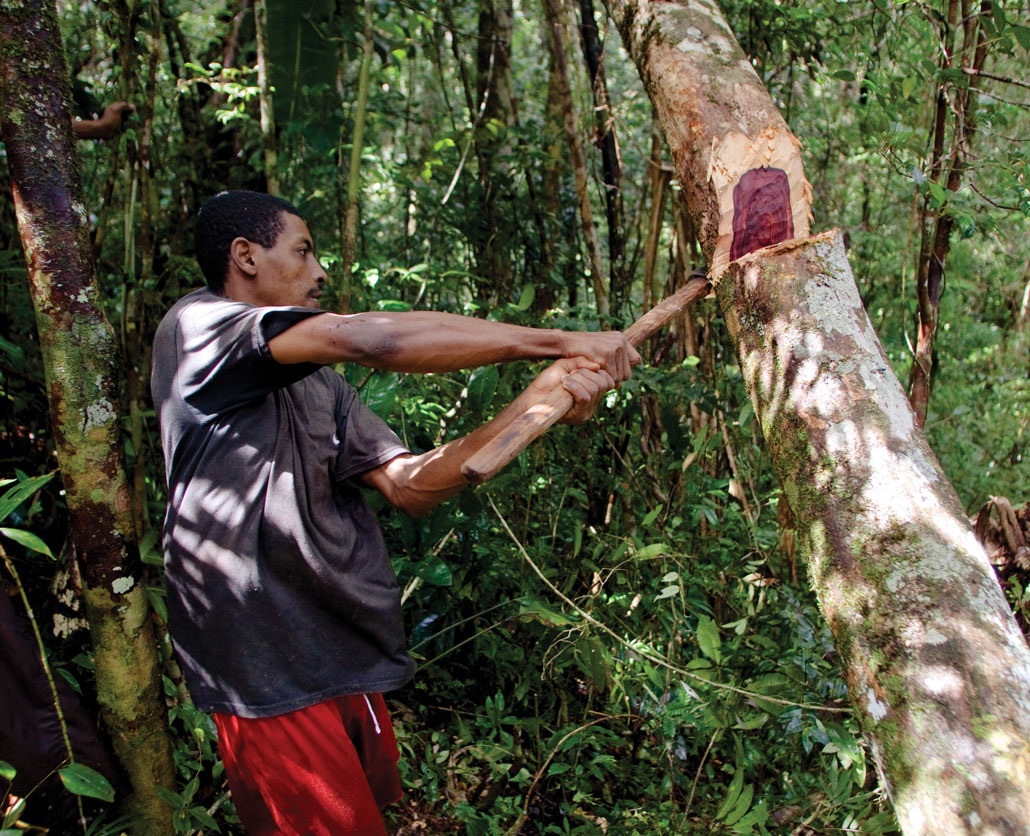 In Madagascar’s Masoala National Park, a man chops down a rosewood tree, exposing its dark red core. The trees are being removed in great numbers, from here and other tropical forests, for production of high-end furniture sold mainly in China.Toby Smith/Contributor/Getty
In Madagascar’s Masoala National Park, a man chops down a rosewood tree, exposing its dark red core. The trees are being removed in great numbers, from here and other tropical forests, for production of high-end furniture sold mainly in China.Toby Smith/Contributor/Getty
Roots of an industry
Rosewood trees, many of which take centuries to grow to full maturity, are important within their ecosystems. In Madagascar, home to some of the world’s most valuable Dalbergia species, the trees are crucial forest habitats for lemurs. One litter of red variegated lemurs (Varecia rubra) was seen nesting in about 40 large, mature trees in Masoala National Park, according to research published in September 2018 in the American Journal of Primatology. As those trees disappear, local extinctions become a risk. In the arid landscapes of mainland Africa, certain rosewood species, such as Pterocarpus erinaceus, can help protect against fires. The trees also pull nitrogen from the air and improve soil fertility for nearby plants.
Regulatory efforts to protect the world’s rosewood trees have increased, at least on paper. Since 2017, all of the world’s Dalbergia species — more than 300 — as well as some other rosewoods have come under the Convention on International Trade in Endangered Species, or CITES, an international agreement that protects endangered animals and plants by restricting their trade across borders. Before that, only seven rosewood species were protected by CITES. At the CITES meeting in August, P. tinctorius, an African rosewood that has been harvested heavily in recent years, was added to the list.
Most rosewood species are classified under CITES Appendix II, which means that trade is allowed but tightly controlled. Before issuing export permits, the exporting countries must assess if a tree species has been sustainably and legally harvested. To determine whether harvesting is sustainable, CITES’ scientific authority in a given country assesses a species’s population, patterns of harvest and geographic range.
CITES has only a limited ability to pressure countries to follow the regulations. “There’s not much the [CITES] secretariat can do besides giving [countries] a slap on the wrist,” says Naomi Basik Treanor, who manages the forest policy, trade and finance initiative at Forest Trends, a Washington, D.C.–based nonprofit.
Even though trade restrictions have expanded in recent years, plenty of rosewood still makes its way out of source countries. Law enforcement officials continue to seize huge rosewood shipments at ports across the world. From 2017 to mid-2018, close to 200 tons of logs, worth an estimated $50 million, were seized in Hong Kong alone.
High value
Out of nearly 165,000 wildlife products seized from 120 countries between 2005 and 2014, rosewood was the largest group based on market value.
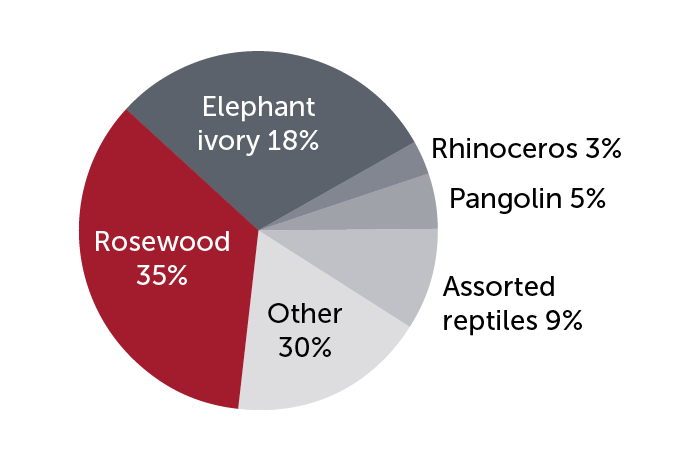 C. Chang
C. Chang
Source: World Wildlife Seizures Database
But prosecution is difficult even in the most flagrant cases. In 2014, Singapore authorities seized nearly 30,000 rosewood logs en route to Hong Kong. The logs, which were restricted under CITES, originated in Madagascar. It was one of the largest wildlife seizures in history. Yet in April this year, Singapore’s high court acquitted the trader and ordered the wood returned to him.
Because rosewood enters China via long and complex trade routes, enforcement is tricky. Along the way, traders can easily falsify the origin of their logs, or hide illegally harvested logs among legal species. Customs officials in China check the paper work that accompanies incoming timber but don’t have the political support or the tools to challenge potentially false claims. And the country has no laws requiring wood and furniture companies to check their timber supply chains.
In contrast, the United States, Australia, Japan and the European Union in recent years passed legislation requiring companies to ensure that timber entering their supply chains is legally harvested. Enforcement of such laws remains limited, partly because identifying the type and origin of wood is not easy.
The United States, for example, has one of the strictest laws prohibiting imports of illegally harvested timber. Yet results of a survey and wood product analysis published July 25 in PLOS ONE show that more than 60 percent of tested wood specimens from major retailers had been wrongly identified. That’s a sign that much of the wood may have been illegally logged and mislabeled at some point in the supply chain.
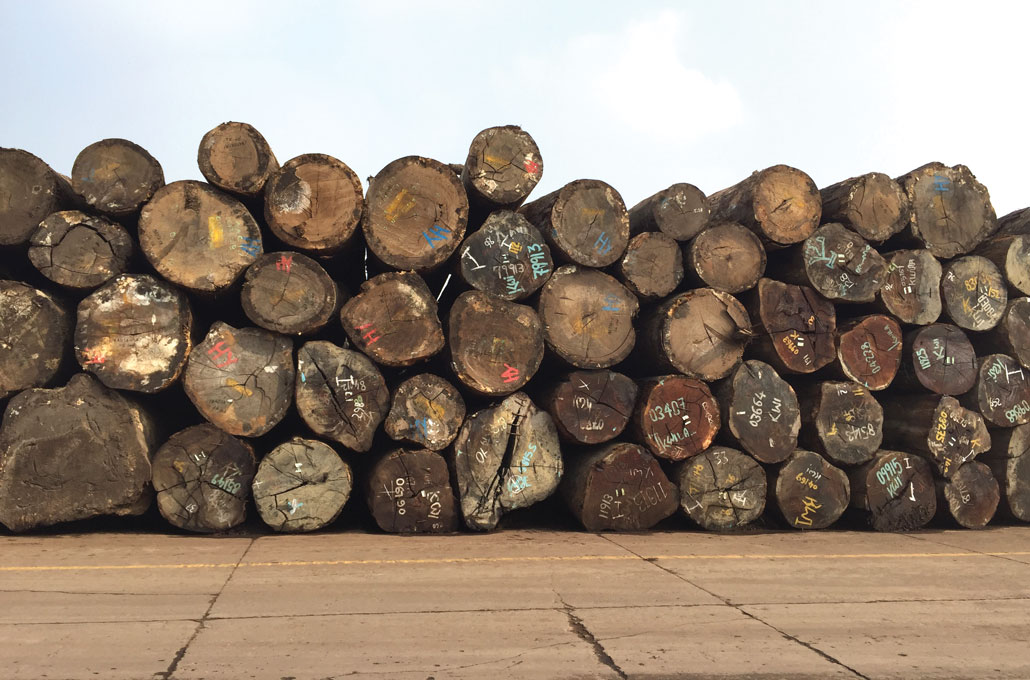 Pterocarpus logs from Africa sit at China’s Zhangjiagang port awaiting transport to wood warehouses or furniture factories.S. Ong
Pterocarpus logs from Africa sit at China’s Zhangjiagang port awaiting transport to wood warehouses or furniture factories.S. Ong
Ideally, policing tropical forests would stop the tree cutting way before any rosewood logs reach foreign markets. But trafficking networks are agile. When a timber supply dwindles or law enforcement gets serious in one locale, the traffickers move to another source, usually in another low-income country. With rosewood in Southeast Asia largely depleted, West Africa now produces an estimated 70 percent or more of the rosewood going into China, Basik Treanor says.
Certain countries, especially in West Africa, find ways to skirt the CITES regulations. Right now, Sierra Leone, Ghana and Mali are among the largest exporters of rosewood in the world, says Susanne Breitkopf, deputy director of forest campaigns for the Environmental Investigation Agency, a Washington, D.C.–based nonprofit. But that might not be true for long.
“It changes year to year, and even month to month. Rosewood trade is like a virus that keeps spreading, affecting those with the weakest immune system,” she says. “If one patient is successfully treated, it immediately jumps on the next, where it can expand with the least resistance.”
And the Chinese traders tend to tap into larger criminal networks that capitalize on corruption and other forms of instability, Basik Treanor says. “The criminal networks don’t care what they’re trafficking in. It could be humans or drugs or weapons or rosewood.”
Mixed bag
Because each approach to identifying trees has drawbacks, people trying to stop trafficking of rosewood logs often cobble together several methods to learn a shipment’s species and where it came from.
| Microscopy | DNA barcoding | Stable isotope analysis | Near-infrared spectroscopy | |
| How does it work? | A thin slice of wood is viewed under a microscope to study cell structure and vessel patterns | Analyzes a portion of a tree’s DNA | Measures the ratio of isotopes of certain elements (e.g., carbon, nitrogen, oxygen) in a tree, which differs based on soil, rainfall, altitude and distance from coast | Wood is illuminated with near-infrared light; chemical bonds in the sample absorb or reflect the light to create distinctive spectra |
| Pros | • Low cost • A good reference database exists for rosewood • Portable devices can be used for on-site analysis |
• Identifies wood at the species level • Only slightly more expensive than traditional wood anatomy identification |
• Can be used on almost all forms of wood, including those that are highly processed or degraded, such as sawn timber or plywood | • Rapid • Nondestructive; no special sample preparation is needed • Portable devices can be used for on-site analysis |
| Cons | • Identifies wood at the genus level | • Performance is poor on old, cut wood or highly degraded wood products, such as plywood • No comprehensive reference database exists |
• Cannot distinguish between different tree species that grow in the same area, since environmental factors are the same • More expensive than DNA barcoding • No comprehensive reference database exists |
• Data analysis requires sophisticated statistics • No comprehensive reference database exists |
Microscopy
How does it work? A thin slice of wood is viewed under a microscope to study cell structure and vessel patterns
Pros
• Low cost
• A good reference database exists for rosewood
• Portable devices can be used for on-site analysis
Cons
• Identifies wood at the genus level
DNA barcoding
How does it work? Analyzes a portion of a tree’s DNA
Pros
• Identifies wood at the species level
• Only slightly more expensive than traditional wood anatomy identification
Cons
• Performance is poor on old, cut wood or highly degraded wood products, such as plywood
• No comprehensive reference database exists
Stable isotope analysis
How does it work? Measures the ratio of isotopes of certain elements (e.g., carbon, nitrogen, oxygen) in a tree, which differs based on soil, rainfall, altitude and distance from coast
Pros
• Can be used on almost all forms of wood, including those that are highly processed or degraded, such as sawn timber or plywood
Cons
• Cannot distinguish between different tree species that grow in the same area, since environmental factors are the same
• More expensive than DNA barcoding
• No comprehensive reference database exists
Near-infrared spectroscopy
How does it work? Wood is illuminated with near-infrared light; chemical bonds in the sample absorb or reflect the light to create distinctive spectra
Pros
• Rapid
• Nondestructive; no special sample preparation is needed
• Portable devices can be used for on-site analysis
Cons
• Data analysis requires sophisticated statistics
• No comprehensive reference database exists
Wood forensics
Forensic techniques have long been used to help identify criminals and ensure the safety of food. Now the tools are being adapted for use in tree sleuthing, with some victories for conservationists.
A U.S. case involving Lumber Liquidators is a model for how governments can use forensics to fight timber trafficking. The Virginia-based hardwood-flooring company was fined more than $13 million in 2016 for importing illegal wood. The penalty was the largest to date for a timber-related violation of the Lacey Act, the U.S. law that bans illegally sourced wood products from entering the country. The company pleaded guilty to importing illegal Mongolian oak (Quercus mongolica) harvested from forests in eastern Russia. Those forests are protected habitat for the world’s last remaining Siberian tigers.
The timber originally had been labeled as Welsh oak from Europe, which is legal to import. Proving the wood’s real origins was difficult. U.S. prosecutors turned to Agroisolab, a German-British firm that specializes in stable isotope ratio analysis. The method measures the ratio of different forms, or isotopes, of carbon, hydrogen, oxygen, nitrogen and sometimes sulfur present in a wood sample. Trees absorb and retain varying levels of these elements depending on soil, rainfall and other environmental factors.
Map the trees
This map shows a stable isotope analysis profile of Madagascar, created using five Dalbergia species. It reveals the relative abundance of deuterium, a stable heavy isotope of hydrogen, and protium, the most common hydrogen isotope. Red shows higher levels of deuterium versus protium; blue shows higher protium to deuterium. Tree samples can be tested and compared to this reference map to learn where the sample probably came from.
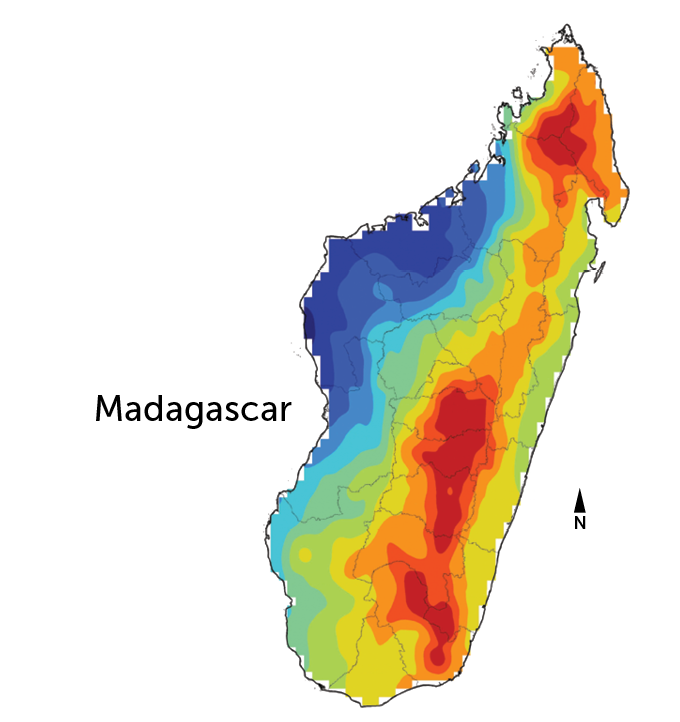 Agroisolab 2019
Agroisolab 2019
To analyze a sample, scientists take a cubic centimeter of wood and grind it into a fine powder and then turn it into a gas for analysis in an isotope ratio mass spectrometer. Separation of the components based on their electric charges and masses indicates the ratio of isotopes present, and therefore which geographic region the wood came from. But as with DNA analysis, there’s got to be a robust database of tree samples to compare the results against.
“Let’s say I commit a crime and my fingerprints are all over the place,” says Pete Lowry, a Paris-based botanist with the Missouri Botanical Garden, a research facility with international reach. Lowry studies some of the world’s most valuable rosewoods, including those from Madagascar. “Unless my fingerprint is in a library someplace, no one is going to know it’s me.”
So Lowry and others are taking “fingerprints” of the world’s trees. The Lumber Liquidators case was an early success story. When Agroisolab didn’t have enough reference material to determine where the company’s oak flooring was from, conservation groups fanned out and collected tree samples from 50 sites in Siberia for comparison’s sake. The forensic evidence helped seal Lumber Liquidators’ fate.
To build the reference databases needed to fight tree crimes, the U.S. government, mainly via the Forest Service, in the last four years has invested hundreds of thousands of dollars in WorldForestID. The network of government bodies, labs and nongovernmental organizations, or NGOs, is creating a library of location-specific wood samples. Researchers from the Forest Stewardship Council, based in Bonn, Germany, are collecting leaf and wood samples from around the world and sending them to London’s Kew Gardens, home of the project’s main library.
Anatomy lesson
Research happening in Zurich and Madagascar is more specific to rosewood. Some of the work is dedicated to low-cost, traditional wood anatomy studies using microscopy. A seasoned professional usually can tell a wood’s genus from its cell structure and vessel pattern, but there are few such experts. Great Britain, for example, has only one.
With microscopy, species-level identification is hard to pull off. Yet good forest policy requires such specificity. Outright bans on logging of entire genera, such as Dalbergia, are unlikely to be approved. So conservationists need to know what can and can’t be chopped down. Better identification techniques could help determine which species, if any, can be sustainably harvested.
“It’s surprising, given the value of the woods, that our understanding of them is very poor,” says Alex Widmer, a plant ecological geneticist at ETH Zurich who studies Madagascar Dalbergia. He presented data in July 2018 in Geneva at a CITES meeting showing that at least 12 known Dalbergia species are each, in fact, more than one species. He used DNA barcoding, which identifies a species based on a short strand of mitochondrial DNA.
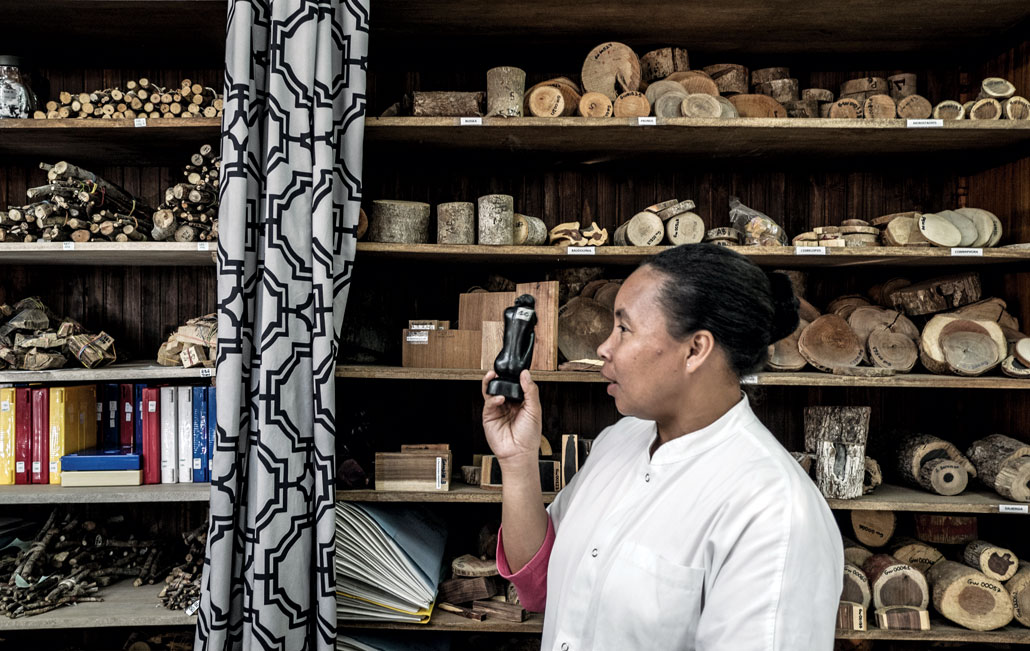 Harisoa Ravaomanalina runs the wood anatomy lab at the University of Antananarivo in Madagascar. She sometimes tests finished products, such as this ebony statuette. Behind her is a shelf full of samples from rosewood and ebony trees.Safidy Andrianantenaina
Harisoa Ravaomanalina runs the wood anatomy lab at the University of Antananarivo in Madagascar. She sometimes tests finished products, such as this ebony statuette. Behind her is a shelf full of samples from rosewood and ebony trees.Safidy Andrianantenaina
Tendro Radanielina is a plant geneticist who has been doing DNA barcoding on rosewood at the University of Antananarivo in Madagascar since 2018. The technology is spreading to the low-income countries that are taking the brunt of the tree loss. The challenge is that the technique requires excellent samples. DNA is easiest to obtain from fresh leaves, or from a tree’s bark or outer sapwood. But the wood doesn’t always come that way.
Many logs sit in stockpiles for years waiting to be exported, or in warehouses waiting to be used. If the wood is already sawed into planks or made into a finished product, the DNA is even more degraded and harder to analyze, says Darren Thomas, CEO of Singapore-based Double Helix Tracking Technologies, a timber verification company.
Because each method has limitations, and no one method can perfectly identify a piece of wood, scientists cobble together a combination of techniques. Radanielina’s university colleague, Tahiana Ramananantoandro, runs a near-infrared spectroscopy lab that is just beginning to conduct rosewood research. A forestry engineer, she’s worked with scientists in Brazil who are developing a portable device that uses the method to distinguish wood species that look similar under a microscope. In Brazil, the scientists’ concern is big-leaf mahogany (Swietenia macrophylla), which is also protected under CITES but is easily confused with the more plentiful crabwoods and cedars.
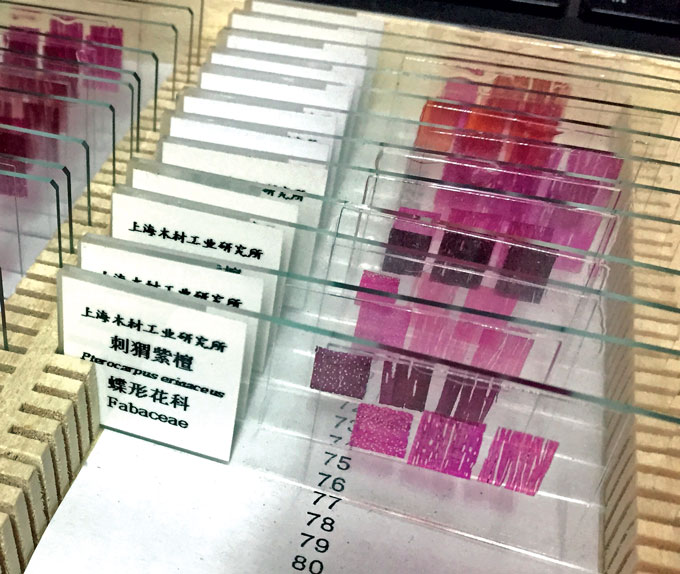 Stained samples of rosewood, sandalwood and other types of wood at the Shanghai Wood Industry Research Institute are used as references when scientists examine the anatomy of a wood sample under a microscope to identify the tree’s genus.S. Ong
Stained samples of rosewood, sandalwood and other types of wood at the Shanghai Wood Industry Research Institute are used as references when scientists examine the anatomy of a wood sample under a microscope to identify the tree’s genus.S. Ong
Near-infrared spectroscopy involves illuminating a thin wood sample with near-infrared light. Chemical bonds within the sample dictate how much light is reflected or absorbed. The result is a characteristic light spectrum, which Ramananantoandro and other researchers can use to help identify the wood.
Shifting demand
For now, a world in which all customs officials have easy access to even one wood identification tool is a distant dream. Less than 1 percent of timber traded around the world is subjected to forensic testing, says forest ecologist Pieter Zuidema of Wageningen University and Research in the Netherlands. Zuidema leads Timtrace, which provides commercial timber tracking services using both genetic and chemical tracing methods.
“One of the barriers is clearly in the development of those techniques and the quality they can deliver,” he says. “Another one is limited knowledge and awareness … and little capacity at customs and authorities to implement them.”
While forensic science offers a glimmer of hope in the fight against deforestation, the fate of rosewood will depend largely on how well the trade is controlled in China. It will take a cultural and political shift to convince people like Jian Zhong Wang to see these trees as more than beautiful furniture worth collecting.

